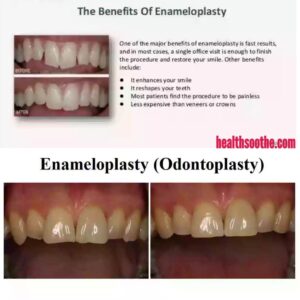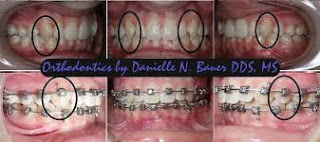What is an Enameloplasty?
The treatment is also sometimes called odontoplasty, and is also applied in remodeling porcelain or composite resin materials for crowns and fillings.
Most people choose to have tooth reshaping if they have chips in a tooth, slightly irregular tooth shapes or over-long canines.
Who Needs Enameloplasty?
 Anyone with teeth where the enamel surface is worn, chipped or fractured can have odontoplasty treatment to restore the teeth through teeth reshaping and polishing. Teeth grinding, or biting on to brittle surfaces can cause teeth to either wear or become chipped. When a tooth is damaged due to decay, enamel may be removed in a separate procedure called enamelectomy before the tooth is restored.
Anyone with teeth where the enamel surface is worn, chipped or fractured can have odontoplasty treatment to restore the teeth through teeth reshaping and polishing. Teeth grinding, or biting on to brittle surfaces can cause teeth to either wear or become chipped. When a tooth is damaged due to decay, enamel may be removed in a separate procedure called enamelectomy before the tooth is restored.How does Enameloplasty contribute to good oral health?
Enameloplasty (also known as tooth reshaping or odontoplasty) is a cosmetic dentistry treatment option where the size and shape of an existing tooth's enamel surface are removed or “shaved” permanently to reshape the contours of the tooth for improved appearance or as a preparation for further treatment, such as veneers or Lumineers. By shaving excess or uneven enamel from the tooth, odontoplasty treatment places the tooth back into proper alignment with other teeth making the teeth healthy and improves tooth structure and bite. The teeth alignment is important to maintain as it works with the facial muscles for proportionate appearance.
If a person has improper bite due to misaligned teeth, this can impact chewing of food and dietary or nutritional needs and also speech pronunciation problem.
Our overall health is very important, the way in which we communicate and our appearance, impact our first impressions with others and also our opportunities in life. When teeth are left chipped or unevenly worn, it is easier for plaque to deposit onto the enamel and accumulate into tartar that can cause tooth decay and gum disease. Having enameloplasty reduces the likelihood of this occurring and gives better oral health and improves overall wellbeing. Is it safe not to have Enameloplasty treatment?
As I mentioned earlier on, enameloplasty (known as tooth reshaping or odontoplasty) is important for overall health. If teeth alignment is left to decay, it can affect not only oral health but also physical and mental health. Having dental treatment to re-contour the teeth reduces the risk of dental problems and ill health in general.
How often should teeth be treated with Enameloplasty?
According to kissdental.co.uk, and recommended dental hygiene standards, everybody should visit their dentist every six months for a general check-up. At these check-ups your resident dentist can examine your teeth to see if any are chipped, worn or fractured.
Your diagnosis will show if enameloplasty is necessary or if other treatments are more advisable. If you have questions about tooth reshaping, contact your resident dentist who will discuss your treatment options with you.
What are the benefits of Enameloplasty?
However, not only does teeth re-contouring or tooth reshaping improve teeth alignment, and therefore bite and facial appearance, but the improved condition of the teeth allow for easier cleaning that reduces the likelihood of tooth decay and gum disease If left unchecked, the infection can spread to the rest of the body causing migraine, hypertension or heart disease. So the overall benefits of enameloplasty extend from oral health to improved physical and mental health too. What procedures are involved in Enameloplasty?
Your resident dentist will initially examine your teeth and take X-rays to see if enameloplasty procedures are appropriate as a treatment for you. If so, then your teeth are cleaned and a tooth reshaping instrument is used to gently shave off parts of the enamel surface to reform the identified teeth for a healthier condition. Once the reshaped, the teeth are smoothed and polished to their natural-looking attractive appearance.
Just for the tooth reshaping procedure, anesthetic is usually not necessary. Your dentist can discuss sedative options with you to help you relax if you feel anxious about receiving treatment. During the procedures, only enamel is meant to be removed, the tooth or its root is not being exposed to the tooth will not feel pain and patients can proceed to eat as usual after treatment.
Is the Enameloplasty procedure safe?
A Dentists, like Cosmetic Dentists, are trained in enameloplasty procedures and to identify when such treatments are necessary, appropriate or not. There are cases where enameloplasty is not recommended, such as teeth with thin enamel where the dentin may be easily exposed, in severe cases of teeth misalignment or cracks, where the gums are highly irritated or are being treated for the disease, or if the reshaping will accentuate improper bite. Your dentist can explain the treatment procedures and possible risks with you at your oral examination.
How much does Enameloplasty treatment cost?
A Cosmetic treatments, such as enameloplasty, and their pricing structures differs from dental practice to dental practice or from country to country, and also depends on the patient-specific diagnosis and oral health condition. Your dentist can discuss treatments and costs with you at your initial consultation, and you can ask further questions too.
Are there alternate any treatments to Enameloplasty?
When teeth are reshaped, it is usually for the same purpose and similar instruments are used. The alternate treatments may be what precede or succeed the enameloplasty procedures. For example, once teeth are shaved, veneers may be bonded to the teeth to enhance natural appearance and also to strengthen the teeth alignment.
Teeth may also be shaved before crowns are fitted to existing teeth. What causes teeth to become worn or chipped may also vary, so alternate treatments like wearing a mouth guard at night to reduce teeth grinding, may be recommended. Your dentist can discuss any alternative treatments that you will need and advise you on treatment options specific to your needs. CREDIT SOURCE
ACCESSED: 02/06/2020
 Anyone with teeth where the enamel surface is worn, chipped or fractured can have odontoplasty treatment to restore the teeth through teeth reshaping and polishing. Teeth grinding, or biting on to brittle surfaces can cause teeth to either wear or become chipped. When a tooth is damaged due to decay, enamel may be removed in a separate procedure called enamelectomy before the tooth is restored.
Anyone with teeth where the enamel surface is worn, chipped or fractured can have odontoplasty treatment to restore the teeth through teeth reshaping and polishing. Teeth grinding, or biting on to brittle surfaces can cause teeth to either wear or become chipped. When a tooth is damaged due to decay, enamel may be removed in a separate procedure called enamelectomy before the tooth is restored.





